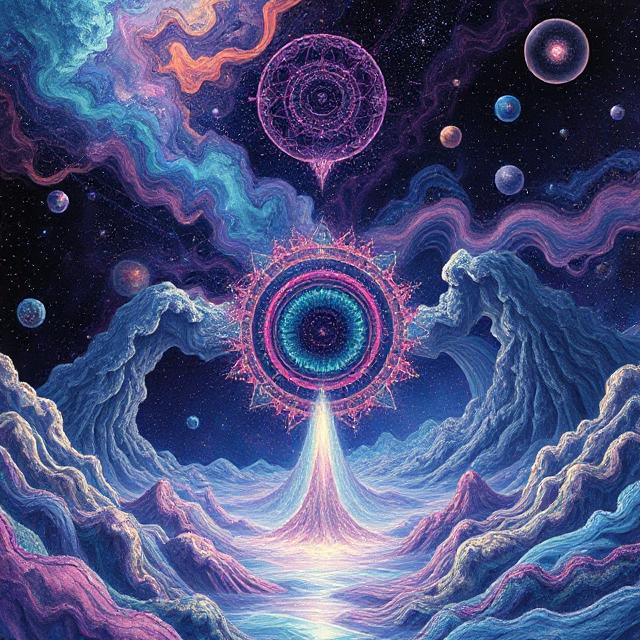
Table of Contents
Do Psychedelics Unlock Gamma or Theta?
TL;DR
Psychedelics often increase both theta and gamma brainwave activity, but in very different ways. Theta is linked to subconscious imagery and emotional release, while gamma reflects moments of high-level integration and insight. Compounds like psilocybin, LSD, and DMT appear to modulate both states — possibly unlocking a rare coherence that bridges intuition with clarity, chaos with insight.
Introduction: Beyond Perception
For millennia, humans have ingested plants, fungi, and synthesized compounds that unravel the seams of ordinary consciousness. But only recently have scientists begun to map the electrical fingerprint of these experiences. What they’ve found is intriguing: psychedelics don’t just “disrupt” normal brain function — they tune it, often amplifying specific brainwave frequencies like theta and gamma.
To understand how this works, we must first grasp what each frequency represents in the unaltered mind.
🧠 Quick Primer: What Are Theta and Gamma Waves?
Theta waves (4–8 Hz):
- Appear during dreaming, deep meditation, and memory formation
- Linked to emotional access, imagination, and the subconscious
- Often surface in hypnagogic states — the borderland between wake and sleep
Gamma waves (30–100+ Hz):
- Represent high-level cognition, sensory integration, and “aha” moments
- Found in states of deep insight, lucidity, and conscious synthesis
- Typically transient — flashing during peak clarity, learning, or coordination across brain regions
So what happens when a psychedelic floods the brain?
Psilocybin and Theta: The Portal to the Inner World
Multiple EEG and MEG studies on psilocybin (the active compound in magic mushrooms) show a significant increase in theta power, especially in medial temporal lobe regions like the hippocampus.
Key Study: Carhart-Harris et al., 2012
- Psilocybin reduced alpha waves (which usually suppress irrelevant input)
- This disinhibition allowed theta waves to surface more strongly
- Participants reported vivid imagery, childhood memories, and emotional waves — classic theta features
Theta activation in this case may reflect a loosening of cognitive filters, allowing material from the unconscious to rise to awareness. This supports the idea that psychedelics simulate a waking dream — lucid yet unstable, emotional yet transcendent.
Gamma Bursts: A Window into Psychedelic Integration?
In contrast to the subconscious flavor of theta, gamma activity reflects clarity — when different brain regions begin working in sync.
DMT and Gamma Spikes
A 2019 EEG study by Christopher Timmermann et al. at Imperial College London found that DMT (dimethyltryptamine) caused:
- Massive bursts of gamma activity, particularly during the onset of effects
- Participants reporting entity contact, ego dissolution, and visual fractals showed the most intense gamma
- These bursts were short-lived but synchronized, often aligning with the “peak” experience
Interpretation:
Gamma under psychedelics may represent the reassembly of cognition — a lightning bolt of meaning, connecting fragmented insights or reconciling paradoxes. This gamma-theta coupling — intuition (theta) + synthesis (gamma) — could explain why users report epiphanies or deep understanding during their trips.
LSD, Brain Entropy, and Mixed Frequencies
LSD presents a slightly different story. Instead of boosting just one band, LSD appears to increase overall signal complexity, or what researchers call “entropy.”
In simpler terms:
- Brainwaves become less predictable, more mixed, and cross-talking
- The Default Mode Network (DMN) — typically dominant in waking thought — is suppressed
- This allows more inter-network communication, including theta-gamma cross-talk
These changes mirror what’s seen during dreaming, meditation, and flow — except now it’s happening awake and intensified.
Theta-Gamma Coupling: The Brain’s Biological Insight Engine
In ordinary cognition, theta-gamma coupling is key for:
- Working memory
- Information encoding and retrieval
- Insight and “aha!” moments
- Creativity
Psychedelics appear to amplify this coupling, resulting in:
- Heightened recall of emotionally charged memories
- New associative links (e.g., “The tree is breathing with me”)
- Unusual yet coherent narratives
In this sense, psychedelics don’t just unlock one frequency — they bridge them. And it’s this synchronization, not chaos, that makes them so cognitively disruptive and illuminating at once.
Caution: Not All Gamma Is Good Gamma
There’s a caveat here.
Excessive gamma has been linked to:
- Seizure activity
- Sensory overload
- Mental fragmentation
And theta in excess may lead to:
- Dissociation
- Rumination
- Depersonalization
This reinforces the idea that context — set and setting — is crucial. Psychedelics don’t create genius or clarity out of nothing. They amplify what’s already there: emotional states, cognitive patterns, and internal narratives. If used improperly, they can flood the mind with too much input — raw and unfiltered.
Summary Table: Psychedelics and Brainwaves
| Brainwave | State Associated | Psychedelic Effects |
|---|---|---|
| Theta (4–8 Hz) | Dreamlike intuition, emotion | Heightened during psilocybin, LSD |
| Gamma (30–100+ Hz) | Insight, unity, lucidity | Brief surges during peak DMT/LSD |
| Alpha (8–12 Hz) | Filtering, relaxed wakefulness | Often suppressed during trips |
| Delta (<4 Hz) | Deep unconscious, sleep | Minimal effect unless sedated |
| Beta (12–30 Hz) | Focus, active thinking | Often disrupted, leading to altered cognition |
Final Thoughts: Altered States, Coherent Frequencies
Rather than “unlocking” one frequency, psychedelics appear to reorganize the entire neural symphony. Theta opens the dream gates, and gamma binds the insights together — sometimes beautifully, sometimes chaotically.
The most profound psychedelic experiences likely arise when theta-gamma coupling is strong and coherent — when the subconscious rises (theta) and the conscious mind can track, name, and integrate (gamma).
For cognitive explorers, this offers an electrifying possibility: not escapism, but neural revelation — not noise, but symphony.
Suggested Reading & Citations
- Carhart-Harris, R.L. et al. (2012). “Neural correlates of the psychedelic state as determined by fMRI studies with psilocybin.” PNAS.
- Timmermann, C. et al. (2019). “Neural correlates of the DMT experience assessed with multivariate EEG.” Scientific Reports.
- Vollenweider, F.X., Kometer, M. (2010). “The neurobiology of psychedelic drugs: implications for the treatment of mood disorders.” Nature Reviews Neuroscience.
- Buzsáki, G. (2006). Rhythms of the Brain. Oxford University Press.
